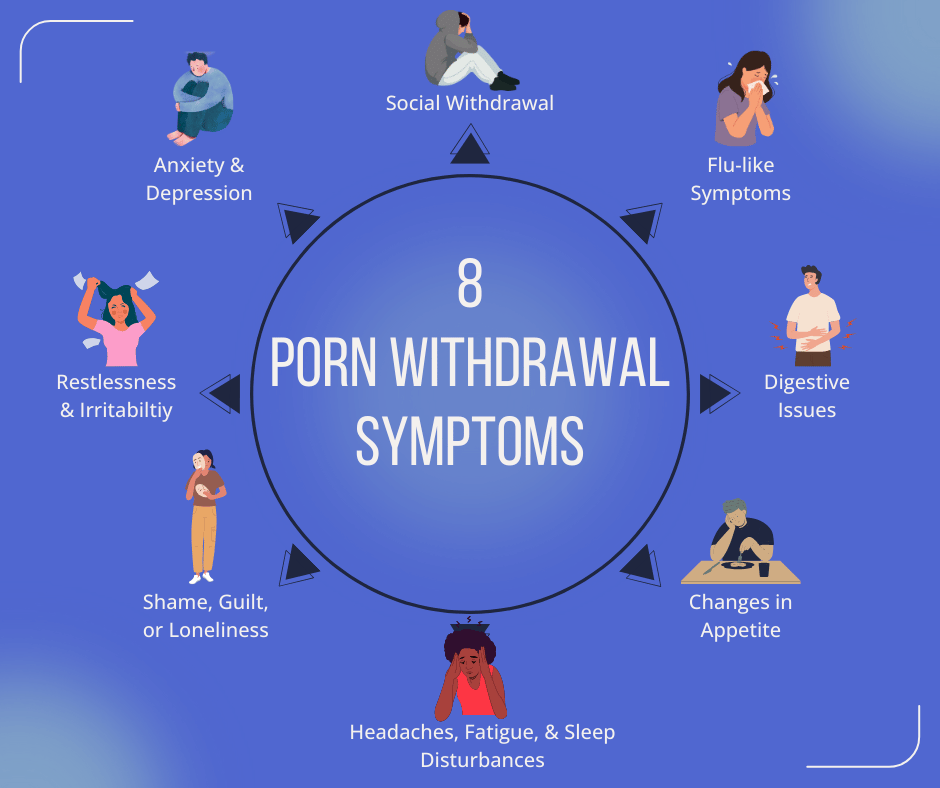Porn Withdrawal Symptoms: 8 Signs and How to Cope
Porn Withdrawal Symptoms: 8 Signs and How to Cope
📅 Updated: July 9, 2025
This article was originally published in September 2024 and has been updated to include new insights and helpful guidance for recovery.
Recovering from porn addiction isn’t easy, and part of the challenge is dealing with the withdrawal symptoms that come with it. The more you know about these symptoms, the better you can handle them and stay on track with your recovery. In this post, we’ll break down what to expect when it comes to porn withdrawal symptoms. We’ll cover the mental and physical effects, how long these symptoms might last, and what factors can impact the timeline. Plus, we’ll share tips on how to cope and where to find support along the way.
Disclosure: This article includes affiliate links to resources we find helpful. We may earn a small commission if you make a purchase, at no extra cost to you.
Jump to Section:
- Understanding Porn Addiction and Withdrawal
- 8 Common Porn Addiction Withdrawal Symptoms
- Porn Withdrawal Timeline: How Long Do Porn Withdrawal Symptoms Last?
- Coping Strategies and Support for Porn Withdrawal
- Recommended Recovery Tools
- Additional Resources

Understanding Porn Addiction and Withdrawal
Porn addiction is a behavioral disorder. It’s characterized by compulsive and excessive consumption of pornographic material, despite negative consequences to one’s mental health, relationships, and overall well-being. Signs of porn addiction can include:
- Preoccupation: Constantly thinking about or planning to watch porn.
- Escalation: Needing more extreme or frequent content to get the same satisfaction.
- Failed Attempts to Stop: Trying to cut back or quit but being unable to.
- Neglecting Responsibilities: Ignoring work, school, or relationships due to excessive porn use.
- Emotional Impact: Feeling guilt, shame, or frustration after viewing porn.
The Neurological Impact of Porn Addiction
Porn addiction, like other addictions, involves the brain’s reward system. This system is responsible for feelings of pleasure and satisfaction. When an individual consumes porn, dopamine is released in the brain, creating feelings of pleasure and reward. However, with repeated exposure, the brain starts requiring more stimuli to achieve the same level of satisfaction. This leads to compulsive behavior and addiction.
When an individual decides to stop consuming porn, they may experience withdrawal symptoms. This is a common occurrence in the recovery process from any addiction. These symptoms can vary in intensity and duration, and can range from mild discomfort to severe distress.
8 Common Porn Addiction Withdrawal Symptoms
The symptoms of porn withdrawal can be quite diverse–varying in intensity and duration, depending on several factors. These factors may include the severity of the addiction, the individual’s overall health, and their support system. It’s important to note that not everyone will experience all these symptoms, as the experience of withdrawal is highly individual. However, there are some common symptoms that many individuals report. These can be broadly categorized into psychological and physical symptoms.

Psychological Symptoms of Porn Withdrawal
Psychological symptoms play a major role in porn withdrawal and can be deeply unsettling. These symptoms can vary in intensity, but they often make the recovery process more challenging. Seeking professional help is crucial in managing these symptoms and supporting recovery. Common psychological symptoms include:
- Anxiety and depression: Feelings of sadness or worry may become more frequent and intense, making it harder to focus on everyday tasks. These emotions often arise as the brain adjusts to the absence of its usual stimulus.
- Restlessness and irritability: Without the usual outlet, individuals may find it difficult to relax or stay calm. This can lead to frustration, mood swings, and a short temper.
- Shame, guilt, or loneliness: Many people experience overwhelming guilt or shame, especially if they have struggled with porn addiction for a long time. These emotions can create a sense of isolation, leaving the person feeling disconnected from others.
- Social withdrawal: The individual may distance themselves from friends, family, or social activities out of embarrassment or fear of judgment. This isolation can increase emotional distress and make recovery more difficult.
Physical Symptoms of Porn Withdrawal
Physical symptoms are another common challenge during porn withdrawal and can vary in intensity from mild discomfort to significant distress. Some of the most common physical symptoms include:
- Headaches, fatigue, and sleep disturbances: Withdrawal often leads to tension headaches and a sense of constant tiredness. Many individuals also struggle with insomnia or restless sleep, making it difficult to feel fully rested.
- Changes in appetite: Some people may find themselves eating more to cope with the withdrawal, while others may lose their appetite altogether. These shifts can lead to weight changes or feelings of discomfort.
- Flu-like symptoms: Muscle aches, chills, and sweating can mimic the symptoms of the flu, leaving individuals feeling physically drained. These symptoms are the body’s way of reacting to the sudden absence of a previously relied-upon behavior.
- Digestive issues: Withdrawal may lead to stomach discomfort, such as nausea, bloating, or constipation. These symptoms often arise due to the body’s stress response and changes in hormone levels.
These symptoms are temporary and will ease over time as the body recalibrates. Consulting with a healthcare professional can help manage these physical effects.

Porn Withdrawal Timeline: How Long Do Porn Withdrawal Symptoms Last?
If you’re going through porn withdrawal, you might be wondering, “How long does porn withdrawal last?” The truth is, everyone’s recovery timeline is unique—but what’s important to remember is that withdrawal symptoms do not last forever. With time, the brain begins to heal, cravings lessen, and emotional balance is restored.
While some people notice improvements in just a few weeks, others may experience lingering effects for several months before they fully adjust. The key is to stay patient and committed, knowing that each day without porn is a step toward lasting change.
Porn Withdrawal Timeline: What to Expect
While there’s no universal timeline, most people experience three distinct phases of porn withdrawal. Here’s what you might expect:
Initial Phase (1-2 weeks): The Hardest Hurdle
This stage is often the most intense as the brain adjusts to the absence of habitual dopamine surges from porn. You may experience:
- Strong cravings and urges to relapse
- Mood swings, anxiety, or irritability
- Fatigue, restlessness, or difficulty sleeping
- Flu-like symptoms such as headaches or muscle aches
💡 Tip: Stay grounded by journaling your thoughts, exercising, and leaning on supportive friends or recovery communities.
Middle Phase (2-8 weeks): The Adjustment Period
Symptoms begin to gradually decrease during this time, though emotional ups and downs may persist. Common experiences include:
- Reduced but occasional cravings
- Improved energy and mental clarity
- Emotional fluctuations, including waves of sadness or frustration
- Better sleep and mood stability
💡 Tip: This is a great time to start forming new habits—explore hobbies, exercise regularly, and strengthen your support network.
Late Phase (8+ weeks): Regaining Control
At this point, most physical symptoms have faded, though occasional cravings or emotional distress may still arise. This is the stage where many people fully regain control and notice:
- Fewer cravings and compulsions
- Stronger emotional regulation and self-confidence
- Improved relationships and overall well-being
💡 Tip: Stay proactive in your recovery—continue practicing mindfulness, setting personal growth goals, and celebrating milestones.
Factors That Influence the Withdrawal Timeline
The length and intensity of porn withdrawal symptoms can depend on several factors. Understanding these can help set realistic expectations and encourage patience throughout the process.
- Severity of Porn Addiction: Those who have used porn frequently for many years or have relied on it as a primary coping mechanism may experience more intense and prolonged withdrawal symptoms.
- Physical & Mental Health: A person’s overall well-being plays a role in recovery speed. Those who maintain a healthy diet, exercise, sleep well, and manage stress tend to recover more quickly.
- Level of Support: Having a strong support system—whether through friends, family, therapy, or recovery groups—can make a huge difference in navigating withdrawal challenges.
- Commitment to Recovery: The more proactive an individual is about recovery—avoiding triggers, engaging in therapy, and adopting new habits—the more manageable and effective the process becomes.
Coping Strategies and Support for Porn Withdrawal
Recovering from porn addiction and withdrawal symptoms isn’t just about breaking a habit—it’s about reclaiming control over your life and well-being. The process may feel overwhelming at times, but with the right strategies and support, healing is absolutely possible. Whether you seek professional help, lifestyle changes, or new coping tools, you’re taking a powerful step toward a healthier, more fulfilling future.
Your Step-by-Step Pornography Recovery Plan
Healing from porn addiction takes time, and withdrawal symptoms may feel intense, especially in the first two weeks. But remember—these feelings are temporary, and every step forward is a victory. The key is to stay committed and focus on long-term strategies that support both your mental and emotional well-being.
This guide will walk you through each phase of recovery, helping you manage cravings, rebuild healthy habits, and create lasting change in a way that feels achievable and supportive
Week 1-2: Managing Initial Withdrawal Symptoms
- Acknowledge Symptoms: Expect cravings, anxiety, restlessness, fatigue, and mood swings. Recognizing them helps with mental preparation.
- Track Progress in a Journal: Document emotions, triggers, and victories to increase self-awareness.
- Join a Support Group: Engage with NoFap, Reboot Nation, or addiction forums for motivation and accountability.
- Block Triggers: Install content-blocking apps and avoid high-risk environments.
- Prioritize Sleep & Hydration: Withdrawal can disrupt sleep—create a bedtime routine and stay hydrated to support recovery.
Week 3-6: Replacing Porn with Healthy Habits
- Exercise Regularly: Workouts boost dopamine levels naturally, reducing withdrawal intensity.
- Adopt a Balanced Diet: Eat protein-rich and nutrient-dense foods to support brain recovery.
- Practice Mindfulness & Meditation: Reduce stress with guided meditation or deep breathing exercises.
- Develop New Hobbies: Fill free time with productive activities like reading, sports, or creative pursuits.
- Seek Therapy if Needed: Consider Cognitive Behavioral Therapy (CBT) to address underlying emotional triggers.
Week 7+: Maintaining Long-Term Recovery
- Identify & Manage Triggers: Recognize high-risk situations and develop coping strategies.
- Strengthen Support Systems: Maintain weekly check-ins with an accountability partner, therapist, or support group.
- Set Personal Goals: Focus on self-improvement, career growth, and social connections to shift attention away from urges.
- Celebrate Progress: Reward yourself for milestones like 30 days porn-free to stay motivated.
- Prevent Relapse: If a slip happens, analyze what triggered it and adjust your strategies without guilt.
Suggested Resources to Support Your Recovery
Recommended Recovery Tools
If you’re looking for practical tools to support you through porn withdrawal and beyond, here are a few therapist-recommended resources:
- The Porn Trap by Wendy Maltz: This book offers compassionate, clear guidance for understanding the cycle of pornography use and practical strategies to break free. Many people find it an empowering companion during recovery.
- The Mindfulness Journal for Addiction Recovery: A guided journal with prompts and exercises to help you process urges, build self-awareness, and develop emotional resilience.
- Habit Tracker Dry Erase Board: A simple, visual tool to mark each day you meet your goals, reinforcing small wins and keeping you motivated.
- Weighted Blanket: Gentle, calming pressure that can help promote deeper sleep and reduce anxiety — essential support for nervous system regulation during withdrawal.
Professional Support & Therapy Options
Cognitive Behavioral Therapy (CBT) for Porn Addiction
- CBT helps retrain thought patterns and develop coping skills.
- Addresses underlying emotional struggles like anxiety or low self-esteem.
Support Groups & Community Help
- NoFap, Reboot Nation, and 12-step programs offer guidance and motivation.
- Group accountability significantly improves long-term success rates.
Medication for Severe Withdrawal Symptoms
- In some cases, a doctor may prescribe medication for anxiety, depression, or impulse control.
- Always consult a licensed professional before considering medication.

Conclusion: You Are Not Alone in Your Recovery
Overcoming porn addiction and managing withdrawal symptoms is a deeply personal journey, one that requires patience, self-compassion, and the right support system. It’s not just about quitting a habit—it’s about rebuilding confidence, improving relationships, and discovering a healthier connection with yourself.
Recovery is not a straight path. There may be setbacks, but every effort—no matter how small—is a step forward. You are not defined by your past, and healing is absolutely possible. With the right strategies, mindset, and professional guidance, you can regain control and create a more fulfilling life.
If you’re in Illinois or Colorado, our experienced therapists specialize in porn addiction counseling and are here to support you. Whether you need help navigating withdrawal symptoms, rebuilding self-esteem, or developing healthier coping strategies, we’re here to walk alongside you.
💙 Take the next step today—give us a call or fill out our confidential intake form to connect with a therapist who understands. You don’t have to go through this alone. Help is available, and healing is possible.
Additional Resources
Check out these other blogs for more information about porn addiction and recovery:
Alexandra Joy Hoerr

Related Articles
-
Achieving Peace of Mind: SMART Goals for Anxiety
Achieving Peace of Mind: SMART Goals for Anxiety 📅 Updated: July 11, 2025 This article was...
Read More -
Sensate Focus Exercises: A Step-by-Step Guide to Building Intimacy
Sensate Focus Exercises: A Step-by-Step Guide to Building Intimacy 📅 Updated: July 10, 2025 This article...
Read More -
10 Symptoms of Daughters of Narcissistic Fathers & How to Heal
10 Symptoms of Daughters of Narcissistic Fathers & How to Heal 📅 Updated: July 10, 2025...
Read More